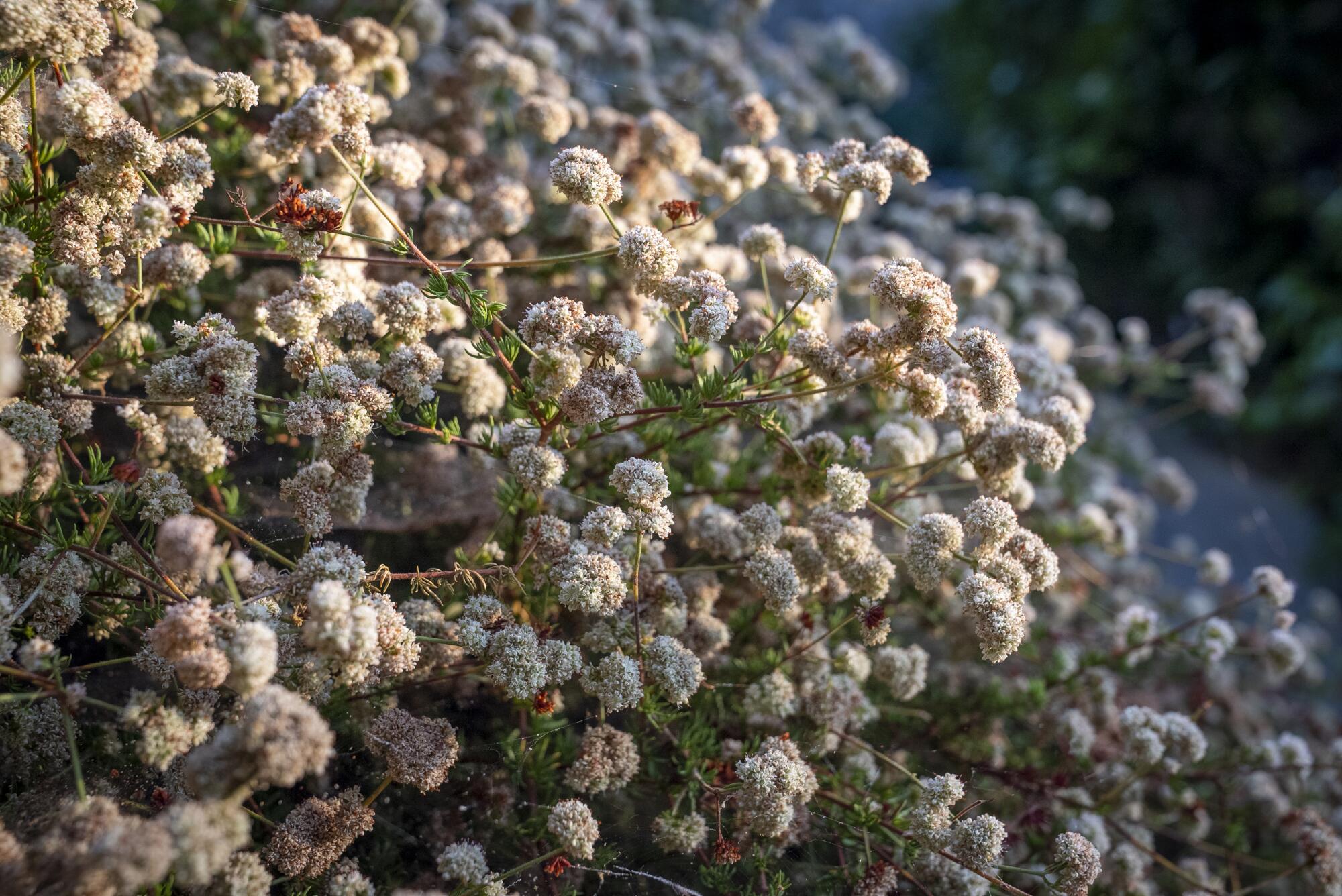If you happen to overlook the polluted Seine, Paris appears to be like so fairly on TV, so quintessentially Parisian, that it raises the query: How will Los Angeles evaluate when it hosts the 2028 Olympics?
We will rhapsodize about our fabulous mountains and seashores, attractive parks and gardens, and plenty of breathtaking residential drives. However that’s not what folks see once they first arrive to Los Angeles or what we encounter most days as we go about our enterprise.
As an alternative, it’s lengthy bleak corridors of concrete and site visitors, off-ramps and intersections choked with weeds and trash, blocks of faceless (or defaced) buildings and entrance yards with boring (or dying) swaths of lawns.
Issues are particularly grim on the entry level for many guests — that interminable development zone often called Los Angeles Worldwide Airport, the place the primary message after leaving the terminal seems to be “Welcome to Hell.”
We will do higher, we should do higher, not just for our guests however ourselves. And the 2028 Olympics are a golden alternative to make some substantial adjustments that won’t solely beautify our metropolis, however have a good time our distinctive pure historical past whereas supporting our threatened pollinators and wildlife.
Think about our parkways lined with beautiful stands of California buckwheat (Eriogonum fasciculatum) as an alternative of weeds.
(Marie Astrid Gonzalez)
Right here’s the plan: Let’s create a marketing campaign to line our yards, our streets and even our airport thoroughfares with the gorgeous and aromatic vegetation that develop natively on this area. And let’s get began within the coming 12 months, so by 2028, when the town is internet hosting athletes and company from all over the world, the plantings will probably be mature and thriving.
In any other case, our worldwide company would possibly discover that L.A.’s public landscapes are embarrassing, “with horribly topped timber, synthetic grass and actually drab vegetation,” mentioned Evan Meyer, government director of the Theodore Payne Basis, one of many area’s premier nurseries and schooling facilities for California native vegetation.
Overlook speed-planting ornamentals for TV close-ups. Making a native plant landscaping marketing campaign across the Olympics is a greater option to extol the area’s ecological heritage whereas giving Los Angeles a badly wanted sprucing up, Meyer mentioned.
“The large query is: What story does Los Angeles need to inform about itself?” Meyer mentioned. “Are we going to be an environmental chief and present the world what California has to supply from a botanical perspective? Or are we going to speak about synthetic grass?”
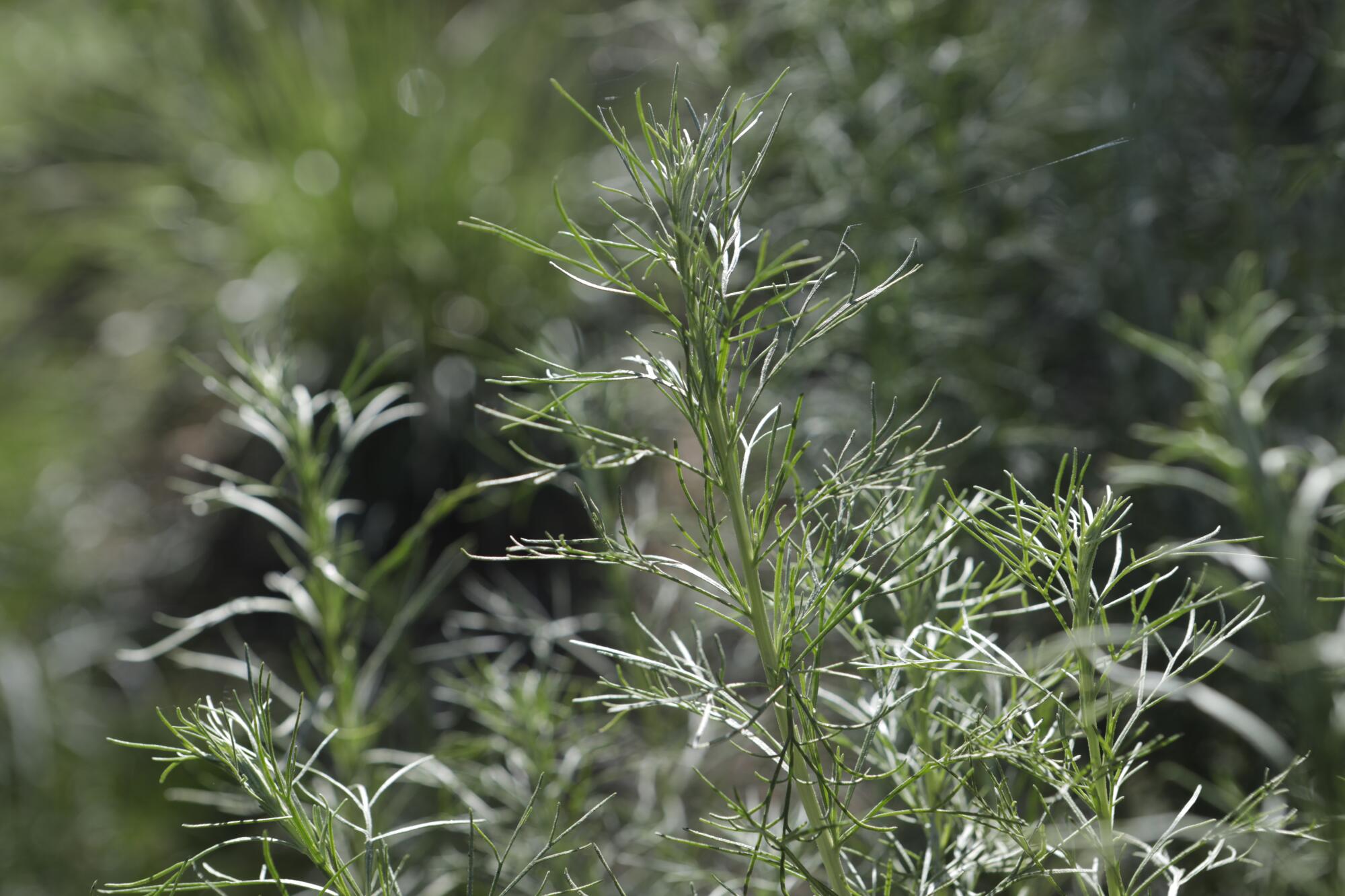
Wispy California sagebrush leaves seize the sunshine and are so aromatic the plant has earned the nickname “cowboy fragrance.”
(Katie Falkenberg / Los Angeles Occasions)
Good factor L.A. is stuffed with every kind of storytellers — beginning with our indigenous individuals who can advise us on the historic makes use of of those vegetation for meals, instruments, shelter and medication, mentioned Bob Ramirez, president of the Gabrielino Tongva Springs Basis’s Kuruvungna Village Springs in Sawtelle, a pure spring utilized by Native Individuals for 1000’s of years.
California is without doubt one of the world’s prime 10 biodiversity sizzling spots, with vegetation that develop nowhere else, Ramirez mentioned. And Native folks included these vegetation into their lives for generations. “It‘s necessary that folks perceive the historical past that was right here earlier than the Spaniards,” he mentioned. “Individuals go to Europe to see the ruins of early empires, however they don’t know in regards to the historic historical past of our area, and native vegetation can present a context for that.”
We’ve got loads of time to get this performed. “It’s only a query of planning,” mentioned horticulturist Carol Bornstein, former director of the character gardens on the Los Angeles County Pure Historical past Museum and co-author of “California Native Vegetation for the Backyard,” one of many area’s most definitive books about native plant landscaping.
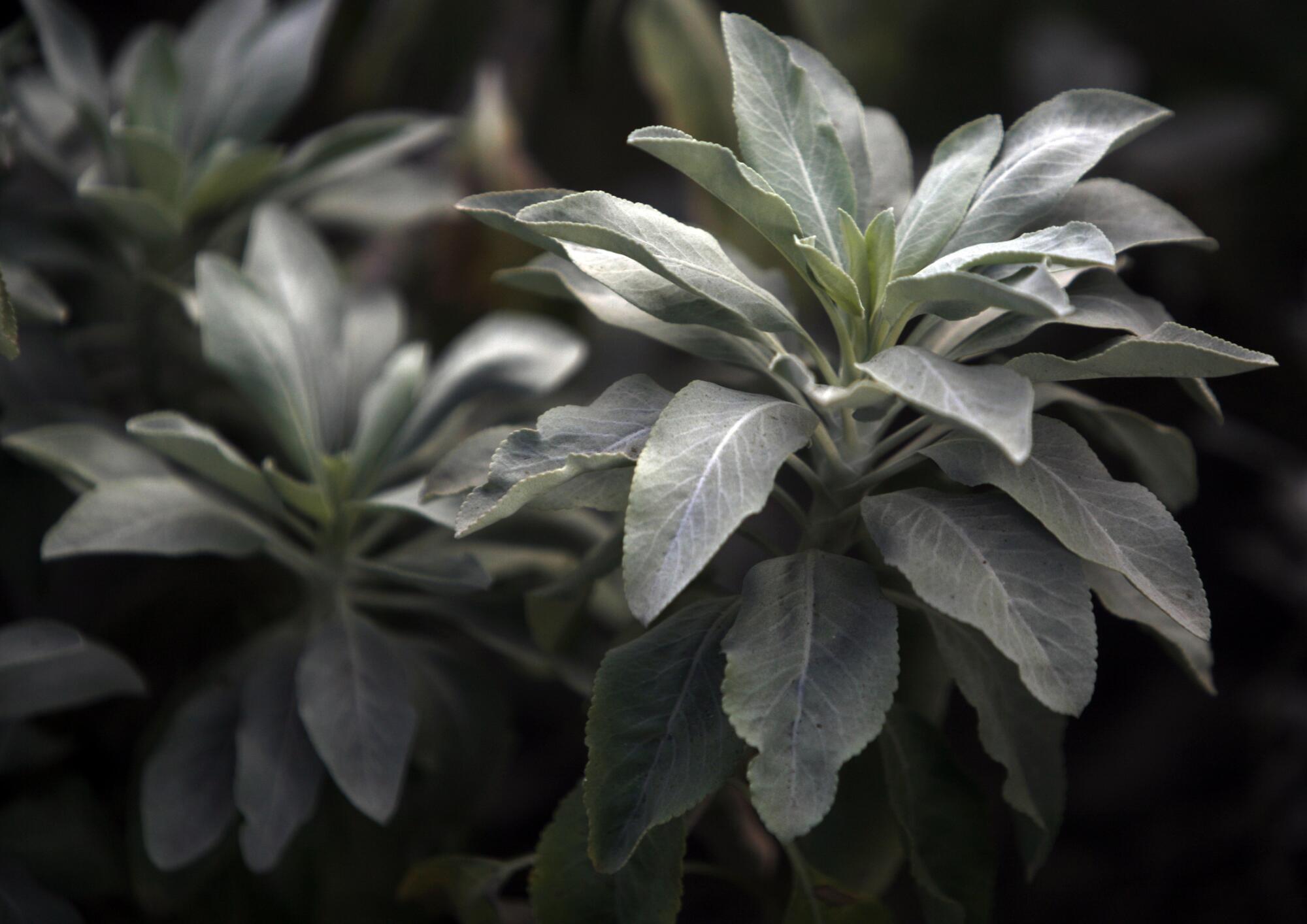
White sage solely grows in Southern California and northern Baja, so it’ll really feel proper at dwelling in most landscapes round L.A.
(Francine Orr / Los Angeles Occasions)
A local plant landscaping marketing campaign isn’t nearly beautifying the town for the Olympics. “It’s about reflecting who we’re as Southern California,” she mentioned. “It’s a option to puff up our chests, so to talk, to indicate what we’re doing in preserving and enhancing our biodiversity.”
To assist inform this story, Bornstein suggests utilizing sleek desert willow timber, which bloom profusely in the summertime and are sufficiently small to reside in containers, and two perennial natives, Gran Canon Baja bush snapdragon and De La Mina verbena, that bloom virtually year-round and do very properly in pots.
Tim Becker, horticulture director of the Theodore Payne Basis, mentioned the push for extra native plantings might develop L.A.’s identification past Hollywood and large site visitors jams. His plant solutions for a marketing campaign would come with utilizing California sagebrush, bush sunflower, California fuchsia and fairyduster.
“The vegetation are the simple half; they’re lovely, they entice helpful pollinators they usually create a way of place,” he mentioned. “The exhausting half is getting a seat on the desk. How will we [native plant advocates] inject ourselves into that decision-making course of?”
Metropolis officers have supported inexperienced initiatives on paper, “however now could be the time to get these vegetation in publicly seen areas,” he mentioned.
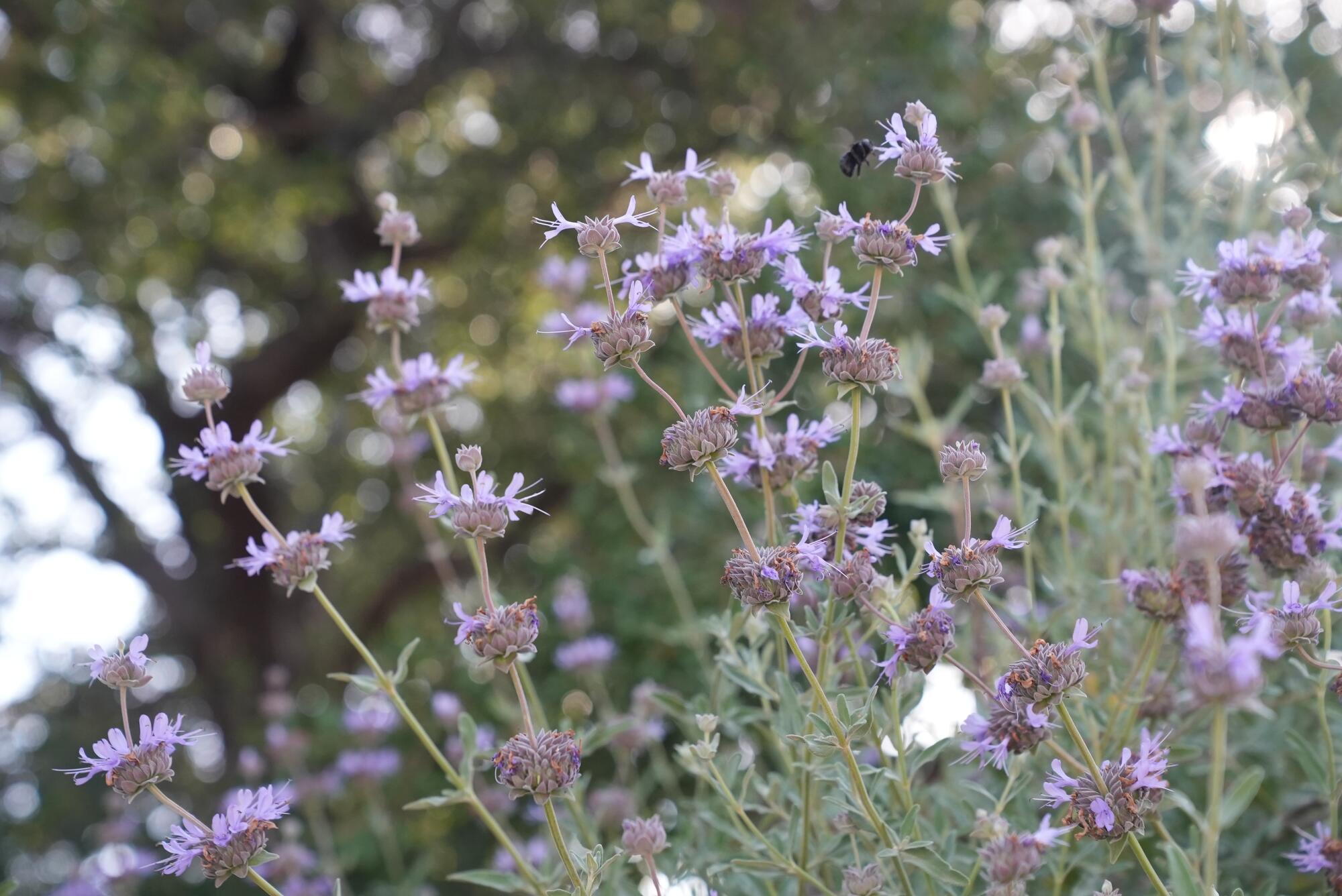
Cleveland sage’s frilly wands of flowers tower over the vegetation gray-green leaves and switch into sculptural brown spikes in late summer time. Bonus: This native plant stays powerfully aromatic year-round.
(Marie Astrid Gonzalez / Los Angeles Occasions)
What Angelenos determine now can have an enormous impact on the area’s picture, now and sooner or later. Simply think about how the beautification work for the 1932 Olympics modified L.A.’s skyline.
Palms timber have been already a SoCal gardening craze across the flip of the twentieth century, in response to the PBS historical past present “Misplaced LA.” However beginning in March 1931, the town cemented their future as L.A.’s iconic timber by planting some 40,000 palms alongside 150 miles of streets, in response to the present, partly to arrange for the Olympics, but in addition to offer jobs for 400 unemployed males through the Nice Despair.
That Olympics’ beautification mission occurred greater than 90 years in the past, and it’s nonetheless reverberating immediately. Palm timber, which feed into the tourism fantasy that Southern California is a tropical paradise, present zero shade, their heavy fronds are a harmful nuisance and maintaining them trimmed is a big municipal expense.
Landscapes with native vegetation, alternatively, would require much less water use, much less air pollution from gas-powered garden mowers and higher help for our threatened birds and bug pollinators.
Tree planting and making a constant tree cover is an overarching suggestion within the metropolis of Los Angeles Public Works Committee’s LA 2028 Olympics Legacy Road Enchancment Plan, however the doc doesn’t listing what timber must be included. Why not go along with solutions from native plant consultants such has Mike Evans, who began his Tree of Life native plant landscaping firm and nursery in San Juan Capistrano practically 50 years in the past?
Evans’ listing of native plant solutions is lengthy, however highlights embody utilizing two of the area’s keystone timber — coast reside oak and Western sycamores — for shade and any number of ceanothus and manzanitas (each of which are available in many sizes and shapes).
Angelenos want to know that range — at the very least 15 to twenty species of vegetation — is vital to making a pure panorama, particularly in the event that they hope to assist pollinators and different wildlife. “It’s not sufficient to only plant a row of ceanothus,” Evans mentioned. “We’ve got a standard tradition of spending time outdoor, and we must always have a good time that in our gardens with native vegetation, as a result of they inform the story of our land.”
Nobody is suggesting a local plant mandate or advocating that Angelenos rip out current non-native landscapes (properly, besides possibly for water-thirsty lawns), however there are such a lot of shade timber that want planting, intersections that want weeding and replanting and companies that want one thing moreover concrete. Why can’t we set some neighborhood objectives round utilizing native vegetation?
Really, we shouldn’t look forward to the town to do all of the cleanup work. Town’s Workplace of Group Beautification provides assets to assist neighborhood members volunteer for cleanups round their neighborhoods.
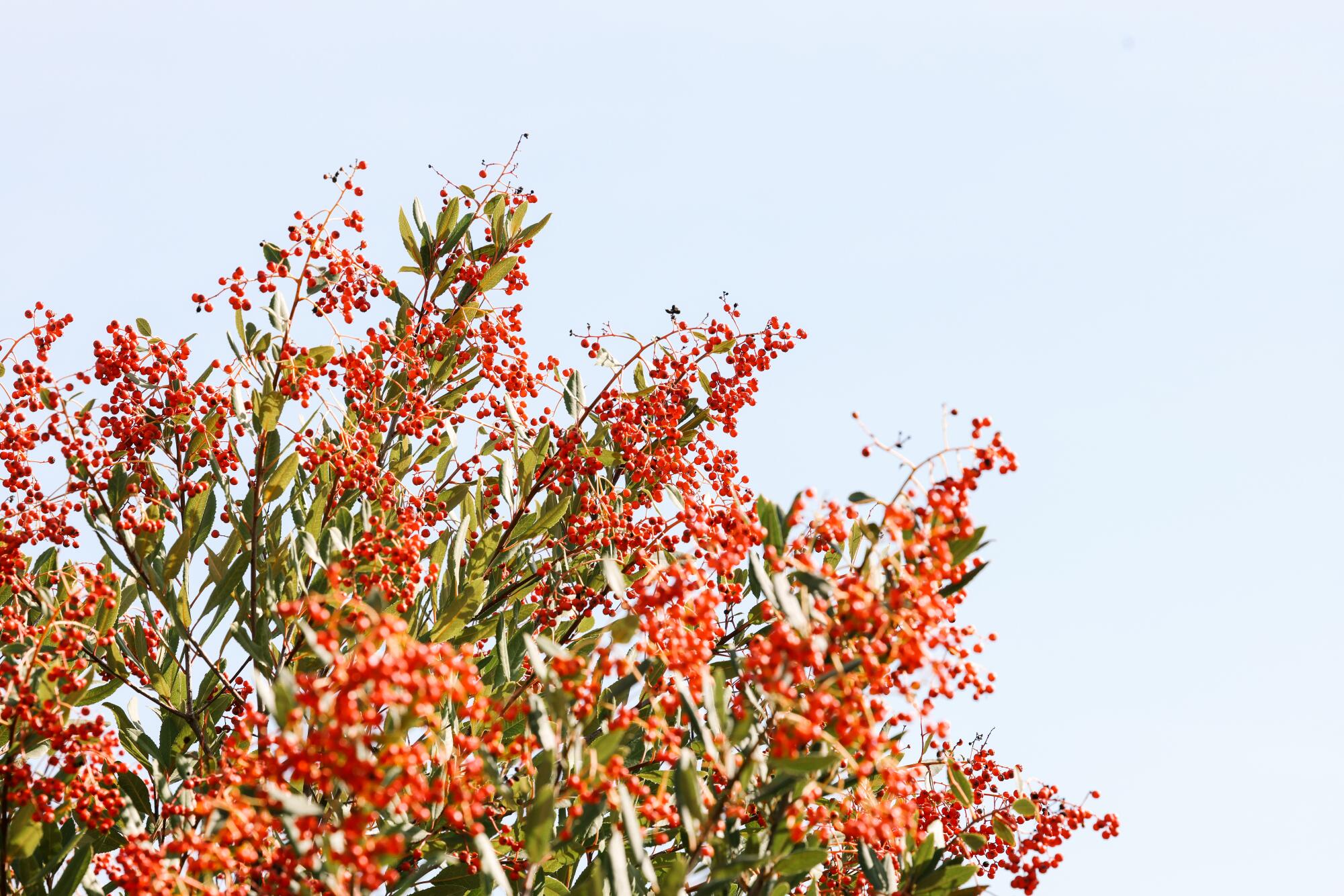
Toyons have good-looking inexperienced holly-shaped foliage in the summertime, shiny flowers within the spring and cheerful sprays of pink berries within the winter.
(Dania Maxwell / Los Angeles Occasions)
Meyer instructed that Angelenos think about a Victory Backyard method for sprucing up their yards, balconies or enterprise fronts. Throughout World Warfare II, households helped the warfare effort by planting vegetable gardens of their yards to release farm-produced meals for our troopers abroad — besides on this case, we’d be rising Olympic gardens to assist Los Angeles inform its story by way of native vegetation.
He additionally advocates planting native milkweeds like slender leaf and woollypod, summer time bloomers that can entice a lot of pollinators, particularly the endangered Western monarch butterflies.
Chaz Perea, a horticulture professor at Mount San Antonio School and panorama supervisor at Dodger Stadium, is remodeling the grounds of the stadium with predominately native plantings. The stadium has practically 20 spherical concrete planters 4 ft tall and 4 ft in diameter, which could be moved with forklifts, which may work for a citywide native plant marketing campaign, he mentioned.
The stadium’s containers are planted with native toyons. “They’re darkish inexperienced and simple to develop they usually create a wall of wholesome lush plant materials,” Perea mentioned. Plus, they flower within the spring and supply clusters of ornamental pink berries within the winter beloved by birds.
Perea additionally likes the thought of rising native Roger’s Pink grapes on trellises in giant containers to offer summer time greenery, fall coloration when the leaves flip pink and gold, and sculptural vines within the winter. He additionally recommends planting lemonade berry and pink flowering sumac to switch non-native hedges.
“I see vegetation as unifiers,” mentioned Brandy Williams of Backyard Butterfly in Vermont Knolls. She weaves native vegetation, Mediterranean local weather vegetation, succulents, greens and herbs into her panorama designs. One option to honor the athletes, she mentioned, could be to create plantings from the 5 completely different Mediterranean climates, recognizing the international locations from every area.
California native vegetation would nonetheless be featured prominently, she mentioned, to help native pollinators. Her suggestions embody a number of buckwheats, together with California buckwheat and Yankee Level ceanothus, an evergreen groundcover that has lovely spring flowers. After it blooms, the plant’s darkish inexperienced branches nonetheless look beautiful within the floor or spilling out of a pot.
Vegetation can carry us all collectively, mentioned Williams, “and that includes California native vegetation is simply one other distinctive option to showcase unity. When folks come to our gardens, they’ll higher perceive our tradition.”


